Would you like to be able to view and save thermal images using your smartphone, whether for work or just for fun? Thanks to technological advances, it is possible today to do this without buying a very expensive dedicated camera.
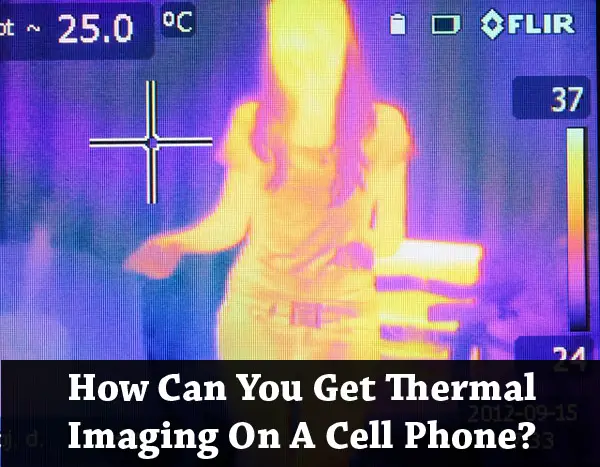
Read on to learn all the options you have to get thermal imaging on your cell phone.
To be able to view and save thermal images on a cell phone, your options include buying a thermal imaging cell phone attachment, buying a phone with an integrated thermal camera, using a thermal app, and modifying your existing phone. More about all these later but lets get into the basics.
Thermal imaging is a useful technology that provides vision at night. The technique identifies subjects by detecting heat from human and animal bodies. Unlike images from ordinary cameras, thermal images do not show the actual color of the scene. This means that the color shown on the screen does not represent the exact color on the ground. That is, red color represents thermal radiations, and blue represents coldness.
What Exactly Is A Thermal Imaging Camera?
A thermal imaging camera is an imaging device that registers heat sensor waves, which is capable of detecting a variance is temperature change. A thermal imager camera works by collecting and detecting infrared radiation from various objects in a scene registering the information as an electronic image showcasing the difference in temperature.
Unlike newer technology designed for making a smartphone thermal camera, most thermal devices are large and cumbersome and need human physical effort and wheels to move about. The imager makes use of a controller, which initiates an image capture system to show an accurate representation of the IV radiation.
For this to work, the infrared sensor detects the various infrared wavelengths emitted by an object. Nonetheless, for it to imprint, an additional optical lens is added to the imager, which virtually overlays over the infrared imager providing additional detailing to the captured image.
With increased technological improvement, most imagers can give an instant visual image of the image captured. Unlike previous systems, you can upload the pictures via a Bluetooth network to another device that you can use for viewing later. Additionally, in tandem with recently released android thermal camera app, you can send the images to others via internet connection in real-time, allowing others also to view temperature change variation. The real-time sharing aspect is especially useful in a work environment hence able to assist when needed.
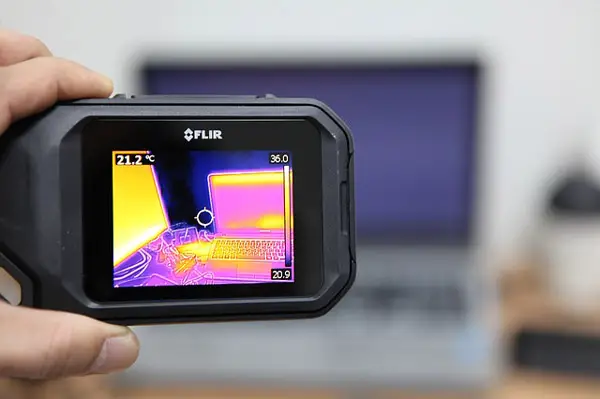
How Thermal Imaging Cameras Work
The thermal imaging camera utilizes a combination of circuits and sensors in the creation of a usable visual image.
Point the thermal imaging device in the general direction of the object or area that requires scanning. The camera lens works by detecting the infrared light emitted by objects within the point of view of the glass.
Scanning of the focused light is achievable, which is varied depending on the focusable power of the lens using a wide array of infrared detectors.
The infrared detector then transfers the scanned image surroundings into temperature pattern in a thermogram. The images produced by the thermogram are at a rapid speed of one-thirteenth of a second, creating a precise and detailed temperature pattern.
At this point, the thermal detector translates the images detected by the thermogram into electric impulses. The electrical impulses transfer to a circuit board, which in turn further decodes the information from the thermal imaging camera detector using specialized chips. As a result, you can get useable data for display on the thermal camera display unit for viewing.
Overall, the signal processing unit sends additional infrared information depending on the various temperature difference of the environment. Plotting of the discrepancies is in varying colors which primarily rely on the heat intensity with red being the hottest and blue being the coldest infrared emission
Simple Ways To Get Thermal Imaging To Work On Your Cellphone
Thermal images are useful for surveillance, navigation, firefighting, HVAC checks, military, and monitoring. Below are some ways in which you can get thermal imaging on your phone.
1. FLIR ONE
Flir is a famous company known for producing thermal imaging cameras. Flir One captures thermal signatures and enables your phone to store the image. It captures the thermal images and dark edges of the visible spectrum and blends both pictures to give the user a clear vision.
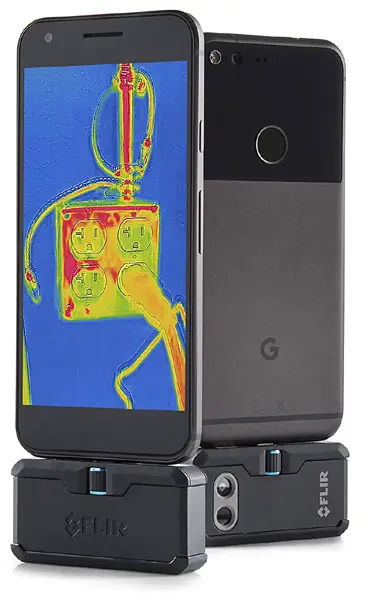
However, the original FLIR One had low resolution and required separate charging. Luckily, FLIR ONE now has a pro model that produces higher resolution images and supports VividIR image processing. This model has a companion app that offers extra features, such as selectable on-screen temperature tracking regions.
Click here to see more information and current pricing on FLIR ONE.
2. SEEK Thermal compact camera
Seek thermal camera allows you to capture thermal images from your scene. These cameras come with a lightning connector. A lighting connector is a simple device that connects your iPhone with other peripheral devices. But note, a Seek thermal compact camera is only compatible with Apple’s smartphone.
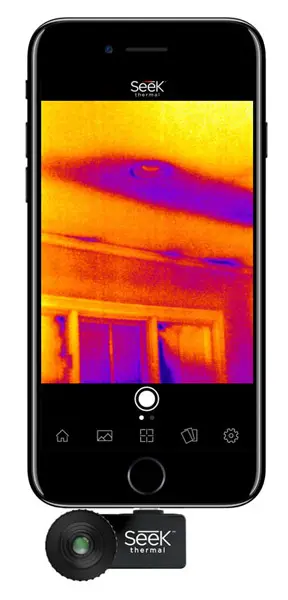
This camera comes with four modes of operation.
a) There is a traditional camera mode that operates as a regular camera.
b) Temperatures mode is used to detect the temperature in a specific spot.
c) Threshold mode allows you to set temperate above which the camera captures thermal images.
d) Lastly, we have the high-low mode.
The good thing about Seek thermal camera is this versatile device turns your smartphone into a thermal camera. But, you must connect your phone to an app.
Click here to see more information and current pricing on the SEEK.
3. Cat S60
Cat S60 is a smartphone integrated with thermal imaging capabilities. The Caterpillar organization produces this smartphone. Caterpillar is a famous company that manufactures machines. These new smartphones are suitable for military personnel and are water-resistant.
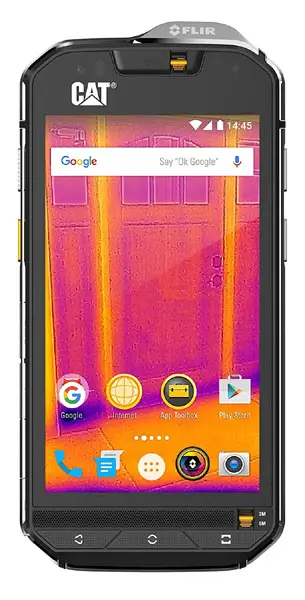
Additionally, it can withstand water pressure up to a depth of 5 meters. The device comes with a lockdown button that uses a shutter to lock down microphones and speakers. Also, it uses the thermal imaging technique to produce standard images that blend with regular photos.
Click here to see more information and current pricing on the CAT.
4. Thermal app
The thermal app is a connection between your thermal camera and phones. It is in an ideal app for android users. The good thing is that it has a standard lens mount suitable for various lens sizes. Compared to thermal cameras, it has relatively low-temperature sensing ranging between 41 and 194 degrees Celsius.
5. Phone remodeling
All smartphones have a sensor plate and lenses and other devices that support circular lens assembly. The lens assembly consists of a small filter known as the IR filter, which is known for its red color. However, IR filters do not capture IR radiations. Such is the reason why regular photographs do not show any emissions.
Thus, instead of utilizing a thermal app download, you can turn your smartphone into a thermal camera by removing the IR filter. However, you should be extremely careful to avoid damaging other parts and then assemble all parts carefully without the screen. Your phone will now work as a thermal imaging camera. To avoid discrepancies and other problems, you may want to first try out with an old phone.
Things to Look For When Investing In Additional Thermal Imaging Gear
Unfortunately, most of the apps in the market are geared for making novelty images and are designed to mimic the look of thermal imaging without being accurate. Additionally, most phones in the market have filters on their cameras that keep making it impossible to attain thermal imaging. Unfortunately, unless you have the necessary skills to turn your phone into a thermal camera, you will end up destroying the camera on your phone leading to further damage to your phone.
Thermal Sensor
Whether you are purchasing the cheapest thermal camera or a slightly expensive one, investing in the right kind of equipment is the right start of detecting infrared light. When searching for one, consider the various sizes of the thermal sensor. Ideally, the larger the thermal sensor, the more accurate the results achieved. When looking for a high-end sensor, consider the 320 x 240 Thermal size sensor
Field Of View
In tandem with the thermal sensor, the field of view also affects the kind of imaging that you will receive. Ideally, most thermal imaging devices in the market provide a range of 15° field of view. Though sufficient for everyday chores like fixing water leakages and the likes, its highly ineffective when setting the HVAC system or in the use of animal detection and rescue and use by firefighters. To ensure you have sufficient coverage, consider choosing equipment providing you with 32° Field of View.
Frame Rate
Investing in equipment that provides you with the right frame rate is the simplest way of getting precise detailing on the area or object you are looking at. Unfortunately, most detectors in the market lack storage capabilities, which make it impossible to save images for later. Additionally, to ensure you are getting the right imaging, having a high frame rate is essential in conveying specific details about the area. For this reason, look for a device giving you an average of < 9 Hz Frame Rate.
Detection Distance
The very best of the best-infrared app is useless if you are unable to use it within a suitable distance. Ideally, you only require a device with limited detection distance when using a heat detector in a domestic setup for minor fixes to save on time. However, in a commercial configuration, this is mainly impossible when results should be from a suitable safe distance.
Cases like animal recapture after a zoo escape or rescue of people in an unstable building are the most critical uses of heat detectors that need sufficient length. For this look for devices that give you between 1000 ft and 1800ft.
Focusable Lens
If you are planning on using the devices in extreme varying temperature, ensuring that your lens power can keep up is vital. The focusable length is essentially the full range of low or high temperature your thermal imaging device can pick up accurately. As expected, the focusable measurement is especially useful in an industrial manufacturing setup as it can detect easily without loss of operation. When choosing consider a focusable length of -40F° to 626°F Detection.
Casing
Even though the heat detector essentially scans high heat intensity, there is a great need to ensure that the device has adequate casing protection. Often, unless the sensor is in use in an open area, heat and water exist concurrently when in use as a cooling element. Including a waterproof casing is a sure way to safeguard your equipment from any water damage when in use.
Storage
Often the use of a thermogram in a heat detector creates a complex system that enables the creation of a heat image. Unfortunately, this by itself is an intricate system that causes it to be bulky. However, to allow for later viewing, there is a need for using a USB thermal camera. The USB compartment provides for the sharing of photos and videos that can then transfer to another device for viewing or documentation.
Temperature
As you measure temperature difference, ensuring that the temperature range is large is essential. Consider the threshold of the device before purchase and decide if it’s suitable for the kind of environment it will work in. Take into account the high and low-temperature range to ensure it will work effectively in both extremes.
Additionally, look into things like a spot temperature, which allows you to know the exact temperature of an area for safety reasons.
Color
The thermal imaging camera uses a wide range of colors to showcase the average temperature of an area of an object. Colors that show extremes are a red color for scorching temperatures and blue for relatively colder temperatures.
However, as there is a need to show the full range of temperatures, different colors like orange and green are in use. Fortunately, with improved technology, you can get up to 9 Color Palettes, which allows for accurate detailing.
Adjustable Emissivity
The primary use of a thermal imager is to measure the amount of heat that an object emits. However, when you need to ensure safety in a potentially fatal environment, understanding the average temperature is vital. Choose a device with adjustable emissivity that can give you an accurate overview of the emitted energy. With this, you can differentiate between organic substances and non-organic substances, allowing you to know which is safe for handling.
Conclusion
Thermal imaging technology demand has increased significantly in the recent past. Thermal images are handy in search and rescue missions and enhancing security. The good news is that you can now use your phone for thermal imaging using the methods discussed above and it has become more affordable than ever.
If you found his article useful visit https://www.ThermalCameras.guide/ for more information on applications of thermal cameras.
Click the following link for an article on the best phones for photographers.








